The emulsion explosive composite plastic film must comply with strict environmental and regulatory standards to ensure the safe storage, handling, and transportation of hazardous materials like emulsion explosives. Compliance is achieved through material selection, structural integrity, chemical resistance, and adherence to international hazardous material packaging regulations. Below are the key aspects of how this film meets these standards:
1. Compliance with International Hazardous Material Packaging Standards
UN Recommendations on the Transport of Dangerous Goods (UN TDG):
The composite plastic film must meet UN packaging performance tests, including drop tests, vibration tests, and chemical compatibility evaluations.
ADR (European Agreement Concerning the International Carriage of Dangerous Goods by Road) and IMDG (International Maritime Dangerous Goods Code):
The film used in explosive packaging must be tested for leak resistance, impact resistance, and durability to ensure the integrity of the packaging in transport.
U.S. DOT (Department of Transportation) and OSHA (Occupational Safety and Health Administration) Regulations:
The film must comply with CFR 49 (Code of Federal Regulations, Title 49), ensuring safe transport and handling of hazardous materials.
2. Barrier Properties and Chemical Resistance
Resistance to Emulsion Components:
The film must be resistant to ammonium nitrate, fuel oils, emulsifiers, and oxidizing agents present in the emulsion explosive to prevent leakage, contamination, or degradation of the material.
Moisture and Oxygen Barrier:
High-barrier polymer layers (such as EVOH, PVDC, or multilayer PE structures) are used to prevent moisture ingress and oxygen penetration, which could destabilize the emulsion.
Anti-static and Anti-contamination Properties:
Some composite films are designed with anti-static coatings to minimize the risk of electrostatic discharge, which is crucial for explosive materials.

3. Structural Integrity & Mechanical Strength
Tensile and Tear Resistance:
The film must be strong enough to withstand mechanical stress during handling and transportation without tearing or rupturing.
Puncture Resistance:
Sharp objects or rough handling should not compromise the film’s integrity. Multilayer structures or reinforced polymer compositions enhance puncture resistance.
Heat-Sealing Strength:
Secure and high-quality heat-sealing ensures that no emulsion leaks during packaging, transport, or storage.
4. Environmental Considerations & Sustainability
Non-toxic and Low-Emission Manufacturing:
The production of the film must comply with RoHS (Restriction of Hazardous Substances) and REACH (Registration, Evaluation, Authorisation, and Restriction of Chemicals) regulations to limit hazardous substances.
Biodegradable or Recyclable Materials:
Some manufacturers are developing sustainable alternatives, such as biodegradable films or recyclable multilayer structures, to reduce environmental impact.
Waste Management & Disposal Compliance:
The film must meet environmental waste management regulations to ensure safe disposal after use, reducing the risk of pollution.
5. Performance Testing & Quality Control
Accelerated Aging and Stability Tests:
The film is tested under high temperature, humidity, and UV exposure to assess its long-term stability when storing emulsion explosives.
Explosive Compatibility Testing:
Direct compatibility tests with emulsion explosives ensure that the film does not react chemically or degrade over time.
Drop and Impact Tests:
Packaging must pass drop tests, compression tests, and vibration tests to simulate real-world transport conditions.



 English
English 中文简体
中文简体














